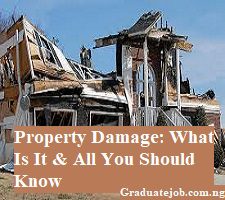Property damage can strike at any time, turning your sanctuary into a headache. Understanding property damage is critical in situations ranging from unexpected accidents to natural disasters. We’ll untangle the complexities of property damage in this detailed guide, describing its causes, types, and legal implications.
Knowing how to negotiate property damage can save you stress and money, whether it’s a busted pipe flooding your living room or a fallen tree ruining your roof. Let’s take a look at property damage and arm you with the knowledge you need to protect your investment.
READ MORE: Business Hazard Insurance: Definition And Cost
What is property damage and what types of property can be damaged?
Property damage refers to the harm, destruction, or loss caused to someone else’s property due to unforeseen events or circumstances. It can include physical harm, reduced value, or destruction of the property, and it often leads to financial and legal consequences.
Property damage can have a wide range of consequences, affecting both real and personal property. These two groups reflect numerous possessions owned by individuals, businesses, and entities. Understanding the different forms of property that can be harmed is critical for understanding the potential implications and adopting preventative steps.
1. Real Property: Real property refers to land and anything that is permanently attached to it. Some of them include:
- Homes and Building: Residential properties, commercial buildings, and industrial facilities are all examples of real property that can be damaged by a variety of factors such as natural disasters, fires, and accidents.
- Land: A sort of real property is land itself. Land damage can occur as a result of erosion, flooding, or contamination.
- Structures on land, such as fences, sheds, and garages, are also considered real property. Weather events, accidents, and other factors can all cause damage to these.
2. Personal Property: Personal property refers to movable possessions owned by persons or entities. This category includes the following items:
- Vehicles: Cars, motorbikes, boats, and other vehicles can sustain damage as a result of accidents, theft, vandalism, and natural calamities.
- Personal property includes items such as smartphones, laptops, televisions, and appliances. Accidents, malfunctions, and external factors can all cause damage.
- Furniture and possessions: Fires, floods, theft, and other accidents can cause damage to furniture, clothing, jewelry, and other personal possessions.
- Artwork, antiques, and collectibles are considered personal property and can be damaged due to accidents, or environmental reasons.
READ MORE: Insurance Endorsement: What It Is All About
What kinds of property damage can occur?
1. Natural Disaster
Natural disasters such as earthquakes, hurricanes, floods, tornadoes, and wildfires can inflict significant damage to physical and personal property.
They frequently cause structural damage, the destruction of personal goods, and the disturbance of daily life.
2. Accidents
Unintentional incidents such as fires, explosions, and car accidents can cause property damage. These catastrophes can happen quickly and cause severe damage to structures, automobiles, and personal belongings.
3. Vandalism and Theft
Deliberate acts of vandalism, burglary, and theft can cause property damage as well as the loss of valuable objects. Graffiti, shattered windows, and stolen valuables are all regular consequences of such situations.
4. Water
Water damage can occur from a variety of sources, including leaks, burst pipes, and flooding. It can cause structural deterioration, mold growth, and property damage.
5. Environmental Factor
Environmental concerns such as erosion, soil subsidence, and land contamination can all have a detrimental impact on property. These factors can jeopardize structural stability and land utilization.
6. Wear and Tear
Wear and tear can cause damage over time, particularly in buildings and infrastructure. Old materials, a lack of care, and exposure to the outdoors can all lead to slow deterioration.
READ MORE: Cheapest Insurance Companies In The United States For 2023
What do you do in case of property damage?
Property damage can be upsetting, but taking fast and right action can help prevent additional losses and ensure a simpler recovery process. In the event of property damage, follow these steps:
1. Assess Safety
Put your own and others’ safety first. If the damage is severe, evacuate the premises and contact emergency authorities if there is a risk to life or health.
2. Take a Record
Take images and videos of the damage from various angles to document it. This record will be critical proof for insurance claims and legal purposes.
3. Notify Authorities:
Depending on the severity of the damage, notify the appropriate authorities. This could involve the local police, fire department, or other authorities.
4. Contact Insurance Provider
Contact your insurance provider as soon as possible to report the damage if you have property insurance. Give them all of the relevant information and paperwork.
5. Limit more Damage
Take prompt action to avert more damage if it is safe to do so. To prevent water incursion, for example, you may need to cover damaged windows or use tarps.
6. Gather Information
Compile a complete inventory of damaged objects, including descriptions, estimated worth, and purchase date if feasible. This will help with insurance claims.
7. File an Insurance Claim
To file a property damage claim, work closely with your insurance carrier. Please include all necessary documentation, including photos, videos, and an inventory of damaged objects.
8. Maintain Communication
Maintain communication with necessary parties such as property managers, landlords, or contractors to ensure that repairs are completed efficiently.






